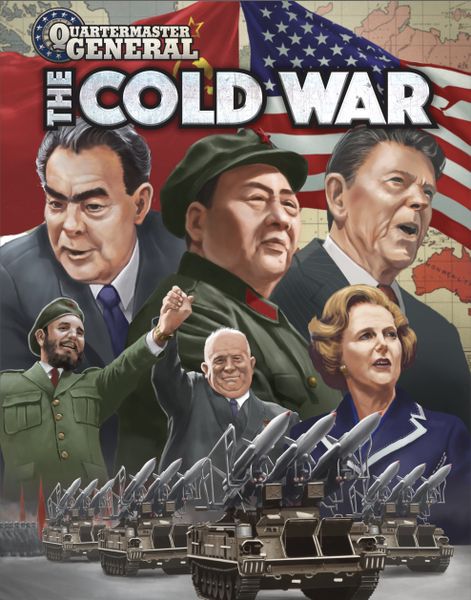Quartermaster General: The Cold War (2018) Board Game
Brief History and Background Information for Quartermaster General: The Cold War
Quartermaster General: The Cold War is a board game that was released in 2018 and designed by Nicholas Avallone. It is a modern warfare and political wargame that simulates the tensions and conflicts of the Cold War era. Players take on the roles of major world powers, such as the United States, Soviet Union, and NATO, as they vie for influence and control over regions around the globe.
Game Components of Quartermaster General: The Cold War
- Game Board
- Unit Tokens
- Cards
- Rulebook
- Dice
How To Setup Quartermaster General: The Cold War
- Place the game board in the center of the table.
- Shuffle the cards and place them in a designated area.
- Each player chooses a major world power to control.
- Place the unit tokens for each player on the board.
- Follow the setup instructions in the rulebook for specific details.
Gameplay Mechanics and Game Objective
The gameplay of Quartermaster General: The Cold War revolves around area majority/influence and hand management mechanics. Players must strategically deploy their units, manage their resources, and control key regions to gain victory points. The objective of the game is to achieve the most victory points by the end of a predetermined number of rounds.
Player Experience
Pros:
- Strategic depth and decision-making opportunities
- Engaging theme that captures the tension of the Cold War era
- Simplicity of rules and mechanics for easy learning curve
Cons:
- Limited player count can lead to exclusion of players in larger groups
- Some randomness in card draws may impact strategy planning
- Components could be of higher quality for the price point
Personal Thoughts on Quartermaster General: The Cold War
Quartermaster General: The Cold War offers an immersive and engaging experience for fans of modern warfare and political strategy games. The game’s mechanics are easy to grasp, allowing for quick setup and gameplay. However, the limited player count and some randomness in gameplay may deter some players looking for a more balanced experience. Overall, Quartermaster General: The Cold War is worth considering for those interested in the Cold War era and strategic board games, but may not be suitable for those seeking a highly competitive or balanced gaming experience.
Game Components of Quartermaster General: The Cold War
How To Setup Quartermaster General: The Cold War
To set up the game, each player or team selects a Bloc: the Soviet Bloc, the Western Bloc, or the Non-Aligned Bloc. Each Bloc has a static initial setup with a selection of armies, air forces, and navies on the board. Players start with 7 cards drawn semi-randomly from their respective decks. The game board is set up with the units and supply symbols in place according to the initial setup rules.
Gameplay Mechanics and Game Objective
Player Experience
**Quartermaster General: The Cold War** offers a dynamic and strategic gameplay experience, particularly suited for families or groups of 3-6 players. The game is highly playable, with each turn representing 2-2.5 years of the Cold War era. Players must manage resources, negotiate with teammates, and balance the use of military force and espionage. The game’s design supports cooperative play within Blocs while maintaining an overall competitive environment.
Pros
Cons
Personal Thoughts on Quartermaster General: The Cold War
**Quartermaster General: The Cold War** is ideal for those interested in strategy games with a historical twist. It is particularly suited for families or groups looking for a game that supports multiple players and offers a quick yet engaging play experience. While it may not be a traditional wargame, it provides a compelling narrative and strategic challenges that make it a great addition to any board game collection. However, players should be aware of the game’s graphic design limitations and the dependency on card draws.
We are supported by our audience. When you purchase through links on our site, we may earn an affiliate commission, at no extra cost for you. Learn more.

